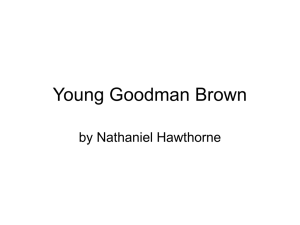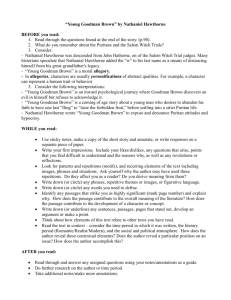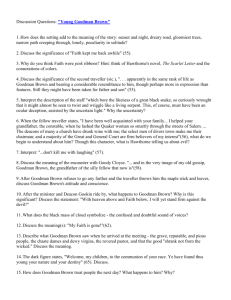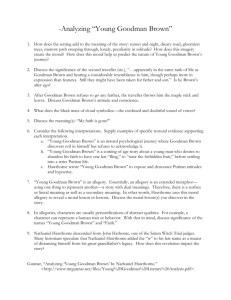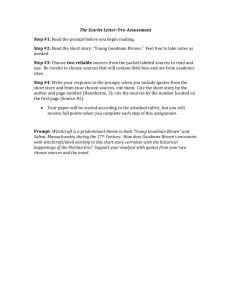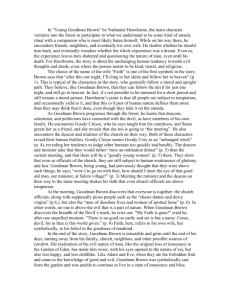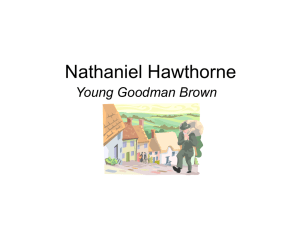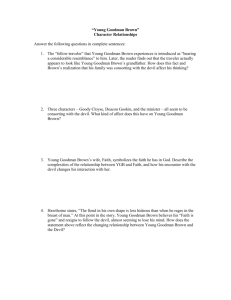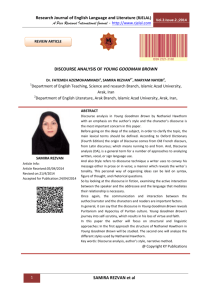Young Goodman Brown Questions
advertisement
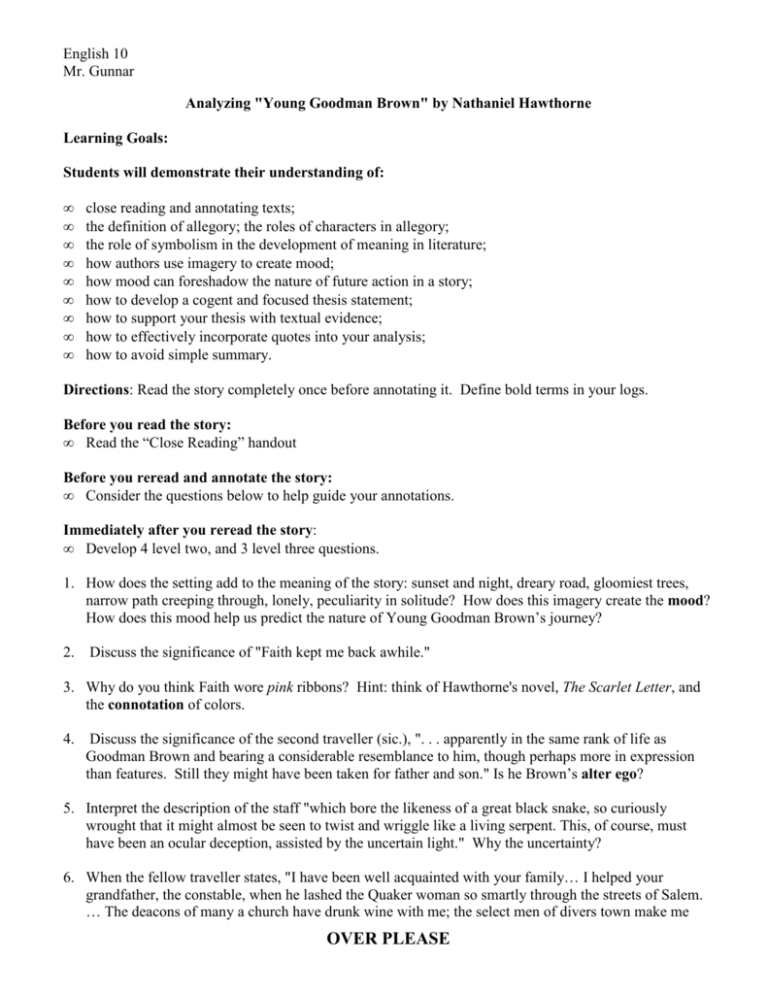
English 10 Mr. Gunnar Analyzing "Young Goodman Brown" by Nathaniel Hawthorne Learning Goals: Students will demonstrate their understanding of: • • • • • • • • • close reading and annotating texts; the definition of allegory; the roles of characters in allegory; the role of symbolism in the development of meaning in literature; how authors use imagery to create mood; how mood can foreshadow the nature of future action in a story; how to develop a cogent and focused thesis statement; how to support your thesis with textual evidence; how to effectively incorporate quotes into your analysis; how to avoid simple summary. Directions: Read the story completely once before annotating it. Define bold terms in your logs. Before you read the story: • Read the “Close Reading” handout Before you reread and annotate the story: • Consider the questions below to help guide your annotations. Immediately after you reread the story: • Develop 4 level two, and 3 level three questions. 1. How does the setting add to the meaning of the story: sunset and night, dreary road, gloomiest trees, narrow path creeping through, lonely, peculiarity in solitude? How does this imagery create the mood? How does this mood help us predict the nature of Young Goodman Brown’s journey? 2. Discuss the significance of "Faith kept me back awhile." 3. Why do you think Faith wore pink ribbons? Hint: think of Hawthorne's novel, The Scarlet Letter, and the connotation of colors. 4. Discuss the significance of the second traveller (sic.), ". . . apparently in the same rank of life as Goodman Brown and bearing a considerable resemblance to him, though perhaps more in expression than features. Still they might have been taken for father and son." Is he Brown’s alter ego? 5. Interpret the description of the staff "which bore the likeness of a great black snake, so curiously wrought that it might almost be seen to twist and wriggle like a living serpent. This, of course, must have been an ocular deception, assisted by the uncertain light." Why the uncertainty? 6. When the fellow traveller states, "I have been well acquainted with your family… I helped your grandfather, the constable, when he lashed the Quaker woman so smartly through the streets of Salem. … The deacons of many a church have drunk wine with me; the select men of divers town make me OVER PLEASE their chairman; and a majority of the Great and General Court are firm believers of my interest," what do we begin to understand about him? Though this character, what is Hawthorne telling us about evil? 7. Discuss the meaning of the encounter with Goody Cloyse. "… and in the very image of my old gossip, Goodman Brown, the grandfather of the silly fellow that now is.” 8. After Goodman Brown refuses to go any farther, the traveller throws him the maple stick and leaves. Discuss Goodman Brown's attitude and conscience. 9. After the minister and Deacon Gookin ride by, what happens to Goodman Brown? Why is this significant? Discuss the statement, "With heaven above and Faith below, I will yet stand firm against the devil!" 10. What does the black mass of cloud symbolize – the confused and doubtful sound of voices? 11. Discuss the meaning(s): "My Faith is gone!” 12. Describe what Goodman Brown saw when he arrived at the meeting – the grave, reputable, and pious people, the chaste dames and dewy virgins, the revered pastor, and that the good "shrank not from the wicked." Discuss the meaning. 13. The dark figure states, "Welcome, my children, to the communion of your race. Ye have found thus young your nature and your destiny." Discuss. 14. How does Goodman Brown treat people the next day? What happens to him? Why? 15. Consider the following interpretations. Supply examples of specific textual evidence supporting each interpretation. Then compose a cogent thesis statement for each interpretation. • “Young Goodman Brown” is an inward psychological journey where Goodman Brown discovers evil in himself but refuses to acknowledge it. • “Young Goodman Brown” is a coming of age story about a young man who desires to abandon his faith to have one last “fling,” to “taste the forbidden fruit,” before settling into a strict Puritan life. • “Nathaniel Hawthorne wrote “Young Goodman Brown” to expose and denounce Puritan attitudes and hypocrisy. 16. "Young Goodman Brown" is a moral allegory. Essentially, an allegory is an extended metaphor – using one thing to represent another – a story with dual meanings. Therefore, there is a surface or literal meaning as well as a secondary meaning. In other words, Hawthorne uses this moral allegory to reveal a moral lesson or lessons. Discuss the moral lesson(s) you discover in the story. 17. In allegories, characters are usually personifications of abstract qualities. For example, a character can represent a human trait or behavior. With that in mind, discuss the significance of the names "Young Goodman Brown" and "Faith." 18. Nathanial Hawthorne descended from John Hathorne, one of the Salem Witch Trial judges. Many historians speculate that Nathaniel Hawthorne added the “w” to his last name as a means of distancing himself from his great-grandfather’s legacy. How does this revelation impact the story?
